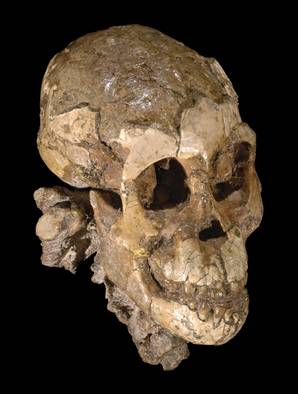Copyright © Jim Foley || Email me

 Discovered by Zeresenay Alemseged in 2000 at Dikika in Ethiopa (Alemseged et al. 2006). This is a well-preserved
3.3 million year old partial skeleton of an approximately 3 year old Australopithecus afarensis child. The fossil
consists of an almost complete skull, hyoid bone, limb fragments, rib fragments, collar bones (clavicles) and shoulder blades
(scapulae), and some vertebrae. It is the most complete juvenile hominid skeleton known until Neandertal times.
Discovered by Zeresenay Alemseged in 2000 at Dikika in Ethiopa (Alemseged et al. 2006). This is a well-preserved
3.3 million year old partial skeleton of an approximately 3 year old Australopithecus afarensis child. The fossil
consists of an almost complete skull, hyoid bone, limb fragments, rib fragments, collar bones (clavicles) and shoulder blades
(scapulae), and some vertebrae. It is the most complete juvenile hominid skeleton known until Neandertal times.
The bipedal features of other A. afarensis fossils are mostly found in this fossil, confirming that afarensis was bipedal. However, there is vigorous debate as to whether bipedalism was its primary method of locomotion, or whether it was combined with a significant amount of tree-climbing (arborealism). The features of Selam's upper body tend to be apelike: the shoulder blade closely resembles that of a gorilla, the finger bones are curved as in chimpanzees, and the semicircular canals are more like those of chimps than humans. All these lines of evidence suggest that A. afarensis was partly arboreal.
The name 'Selam' means 'peace' in the local Ethiopian language. Because it belongs to the same species as Lucy, the fossil has also been nicknamed 'Lucy's child', though it is actually about 100,000 years older than Lucy.
Alemseged Z., Spoor F., Kimbel W.H., Bobe R., Geraards D., Reed D. et al. (2006): A juvenile early hominin skeleton from Dikika, Ethiopia. Nature, 443:296-301.
Wood, B. (2006): Palaeoanthropology: a precious little bundle. Nature, 443:296-301. (the Dikika skeleton)
This page is part of the Fossil Hominids FAQ at the talk.origins Archive.
Home Page |
Species |
Fossils |
Creationism |
Reading |
References
Illustrations |
What's New |
Feedback |
Search |
Links |
Fiction
http://www.talkorigins.org/faqs/homs/selam.html, 11/29/2007
Copyright © Jim Foley
|| Email me 